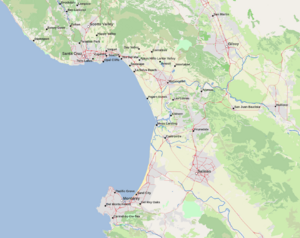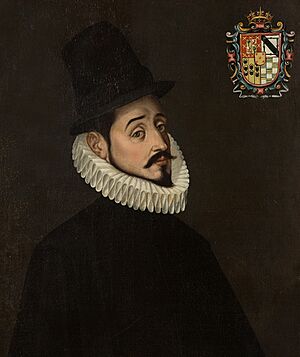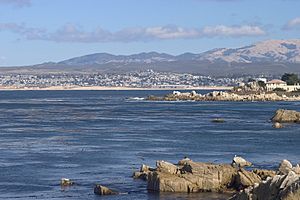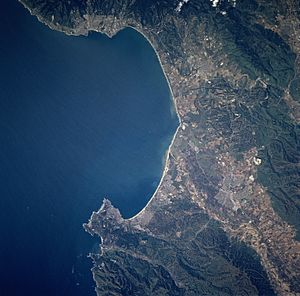Monterey Bay facts for kids
Monterey Bay is a large bay on the coast of California, in the United States. It's located south of the San Francisco Bay Area. The famous city of San Francisco is about 75 miles (120 km) north of Monterey Bay.
At the northern end of the bay is the city of Santa Cruz. At the southern end, on the Monterey Peninsula, is the city of Monterey. Sometimes, people call the whole area around the bay, including parts of Santa Cruz and Monterey counties, the "Monterey Bay Area."
Contents
How Monterey Bay Got Its Name
The first European explorer to reach Monterey Bay was Juan Rodríguez Cabrillo. He sailed into the bay on November 16, 1542. He was on a Spanish naval trip and named the bay Bahía de los Pinos, which means "Bay of Pines." He probably chose this name because of the many pine trees he saw around the southern part of the bay. Even though his name for the bay isn't used anymore, the western tip of the peninsula is still called Point Pinos.
Later, on December 10, 1595, another explorer named Sebastián Rodríguez Cermeño sailed through the bay. He called it Bahía de San Pedro to honor Saint Peter Martyr.
The name we use today, Monterey Bay, was given in 1602 by Sebastián Vizcaíno. The Spanish government had asked him to create a detailed map of the coast. On December 16, 1602, he sailed around a large peninsula and entered the bay. He named it Puerto de Monterrey (Port of Monterrey). This was to honor Don Gaspár de Zúñiga y Acevedo, 5th Count of Monterrey, who was the governor of New Spain (a large Spanish territory that included Mexico and parts of the U.S.). The name "Monterrey" comes from Monterrei, a town in Spain where the governor and his father were from.

All the other places nearby that have "Monterey" in their name, like the Presidio of Monterey (an old fort), the City of Monterey, the County of Monterey, and the Monterey Canyon, were named because they are close to the bay.
What is the Monterey Canyon?
The Monterey Canyon is one of the biggest underwater canyons in the world! It starts off the coast near Moss Landing, right in the middle of Monterey Bay. This canyon is about 249 miles (400 km) long. Its shape can change because of ocean currents and sand moving around. The canyon is very deep, much like a mountain valley on land, and different kinds of sea life live in different parts of it.
Animals and Plants of Monterey Bay
Monterey Bay is a busy home for many amazing sea creatures! You can find many marine mammals here, like playful sea otters, shy harbor seals, and speedy bottlenose dolphins. It's also a stop on the long journey for migrating gray and humpback whales. Elephant seals even come here to have their babies. Sometimes, killer whales (orcas) visit the coast, especially when gray whales are migrating, as they hunt them.
Many types of fish, sharks, and mollusks like abalone and squid also live in the bay. You might also spot different kinds of birds and sea turtles. The bay is famous for its "kelp forests." These are like underwater forests made of tall kelp plants, some growing as tall as trees!
Protecting the Ocean: Marine Protected Areas
Around Monterey Bay, there are special places called marine protected areas. These are like underwater parks! Some of them include the Soquel Canyon State Marine Conservation Area, Portuguese Ledge State Marine Conservation Area, Pacific Grove Marine Gardens State Marine Conservation Area, Lovers Point State Marine Reserve, Edward F. Ricketts State Marine Conservation Area, and Asilomar State Marine Reserve. These protected areas help keep the ocean wildlife safe and protect the amazing underwater ecosystems.
Towns and Cities Around Monterey Bay
Many towns and cities are located around the edge of Monterey Bay. Here are some of them, going clockwise from north to south:
- Santa Cruz
- Capitola
- Aptos
- Rio del Mar
- La Selva Beach
- Moss Landing
- Marina
- Seaside
- Sand City
- Monterey
- New Monterey
- Pacific Grove
- Carmel
- Carmel Highlands
Monterey Bay in Pop Culture
Did you know that Apple's computer operating system, macOS Monterey, is named after this beautiful region?
Images for kids
-
Monterey Bay as seen from Soquel, California. You can see the Moss Landing power plant far away.
-
Scuba diving lessons happening in the bay, near Monterey, California.
-
A painting by Albert Bierstadt called "Bay of Monterey."
See also
 In Spanish: Bahía de Monterrey para niños
In Spanish: Bahía de Monterrey para niños











